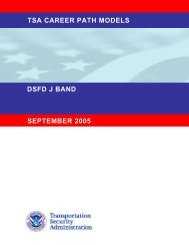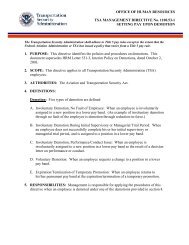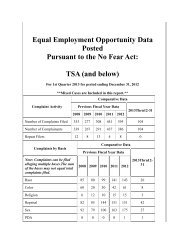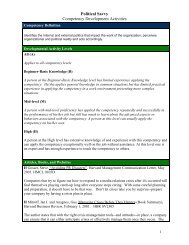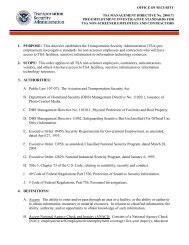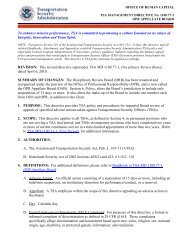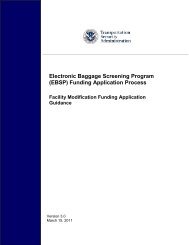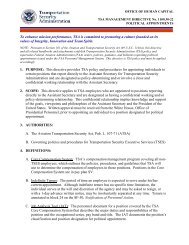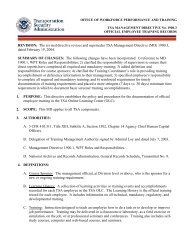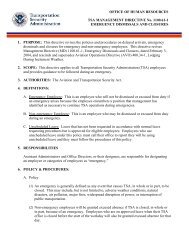Customer Service Competency Development Activities
Customer Service Competency Development Activities
Customer Service Competency Development Activities
Create successful ePaper yourself
Turn your PDF publications into a flip-book with our unique Google optimized e-Paper software.
<strong>Competency</strong> Definition<br />
<strong>Customer</strong> <strong>Service</strong><br />
<strong>Competency</strong> <strong>Development</strong> <strong>Activities</strong><br />
Anticipates and meets the needs of both internal and external customers. Delivers high-quality<br />
products and services; is committed to continuous improvement.<br />
<strong>Development</strong>al Activity Levels<br />
All (A)<br />
Applies to all competency levels<br />
Beginner-Basic Knowledge (B)<br />
A person at the Beginner-Basic Knowledge level has limited experience applying the<br />
competency. He/she applies general knowledge in common situations but has limited practical<br />
experience in applying the competency in a work environment presenting more complex<br />
situations.<br />
Mid-level (M)<br />
A person with mid-level proficiency has applied the competency repeatedly and successfully in<br />
the performance of his/her job but still has much to learn about the advanced aspects or<br />
behaviors associated with the competency. A person at this level can usually apply the<br />
competency on his/her own.<br />
High (H)<br />
A person at the High level has extensive knowledge of and experience with this competency and<br />
can apply the competency exceptionally well on the job without assistance. At this level one is<br />
an expert and has enough experience to teach the competency to others.<br />
Articles, Books, and Websites<br />
A Anders, George, "360-Degree <strong>Customer</strong> Care", Fast Company, July, 2001. Thomas M. Siebel,<br />
founder of Siebel Systems Inc, shares five of his best insights for connecting with and meeting<br />
the complex demands of customers.<br />
A Zemke, Ron, Anderson, Kristin, Delivering Knock Your Socks Off <strong>Service</strong> (3rd Edition),<br />
AMACOM, October, 2002.<br />
Provide a crash course in how to care for customers and how to make exemplary service happen<br />
in an organization time and time again. Contains pragmatic and easy-to-remember concepts and<br />
skills that can be applied immediately.<br />
A Evenson, Renee, <strong>Customer</strong> <strong>Service</strong> 101: Basic Lessons to Be Your Best, Bull's Eye<br />
1
Publishing, July, 1997.<br />
<strong>Customer</strong> <strong>Service</strong><br />
<strong>Competency</strong> <strong>Development</strong> <strong>Activities</strong><br />
Evenson gives clear and basic rules for outstanding customer service. Subject by subject, she<br />
gives easy pointers on how every person in contact with a customer, both in person and on the<br />
phone, can give outstanding and sincere service.<br />
A Leland, Karen, Bailey, Keith, Bateman, Giles H., John Wiley & Sons, <strong>Customer</strong> <strong>Service</strong> for<br />
Dummies (2nd Edition) September, 1999.<br />
Designed to instruct you on how to understand key customer service concepts, plan and<br />
implement a customer service strategy, foster good face to face and telephone service, improve<br />
e-mail and Internet communications, and deal effectively with angry or abusive customers.<br />
A Keenan, William Jr., "<strong>Customer</strong> Turnoffs", Industry Week, June, 2001.<br />
This article discusses disconnect between service intentions and reality and the three categories<br />
of customer turnoffs that account for 97% of all responses to the author's survey on the topic.<br />
M Jonathan Byrnes, Nail <strong>Customer</strong> <strong>Service</strong>, HBS Working Knowledge, January, 2005.<br />
When you do a good job of fixing a customer service problem, you often earn more customer<br />
loyalty than if there had been no problem. This is when you can show your worth, and earn your<br />
customer's trust. This article provides some examples worth following<br />
H Zemke, Ron, Woods, John A., Best Practices in <strong>Customer</strong> <strong>Service</strong>, AMACOM, January,<br />
1999.<br />
A one-stop resource that brings together the wisdom of dozens of customer service experts who<br />
explain and demonstrate how to implement the best practices available in customer service.<br />
H Ford, Robert, Heaton, Cherrill P., Brown, Stephen W., Delivering Excellent <strong>Service</strong>: Lessons<br />
from the Best Firms, California Management Review, October, 2001. CMR214<br />
Delivering excellent service is a challenge for most organizations. Although many aspire to it,<br />
the evidence from customer satisfaction surveys indicates that too few firms are able to deliver<br />
service excellence. On the other hand, some organizations consistently deliver excellent service.<br />
This article reviews ten lessons these benchmark service organizations have learned and shows<br />
how these organizations use them to meet and exceed the ever-rising expectations of their<br />
customers. These lessons can be emulated by any organization seeking such excellence.<br />
H Jeff Gee, Valerie Gee, Super <strong>Service</strong>: Seven Keys to Delivering Great <strong>Customer</strong><br />
<strong>Service</strong>...Even When You Don't Feel Like It!... Even When They Don't Deserve It! McGraw-<br />
Hill Trade, July, 1999.<br />
In this book, Jeff and Valerie Gee share their straightforward, techniques and guidelines for<br />
coping with angry customers, minimizing stress, and making customer service providers feel<br />
2
<strong>Customer</strong> <strong>Service</strong><br />
<strong>Competency</strong> <strong>Development</strong> <strong>Activities</strong><br />
great about doing their jobs. They discuss a new upbeat approach to front-line customer service,<br />
and how people who enjoy their work the most, provide the best customer service.<br />
<strong>Activities</strong><br />
A Organize customer service planning sessions with your staff to elicit ideas for how to improve<br />
customer service without sacrificing security.<br />
B Practice using active listening techniques when communicating with the customer. Take notes<br />
on conversations that are not documented. Contact the customer one week after a complaint has<br />
been resolved to check on his or her satisfaction level.<br />
B Shadow individuals with a reputation for customer satisfaction and observe the ways in which<br />
they work with their customers.<br />
B Test your understanding of customer needs by making a list of what you believe each of your<br />
customer's needs are. Ask your customer to list their needs. Compare the two lists and identify<br />
the differences.<br />
M Have regular one-on-one conversations with customer points-of-contact to solicit ongoing<br />
feedback on performance and customer service.<br />
H Set up reminders to check in with customers (e.g., stakeholders, senior staff), even when there<br />
are no specific problems or issues.<br />
H Talk with others to better understand how they have turned around problem customers (i.e.,<br />
share success stories).<br />
H Use a variety of contact methods for keeping in contact with and maintaining visibility with<br />
the customer.<br />
H Visit other airports where TSA has established a reputation for exceptional customer service.<br />
Coaching Suggestions for Managers<br />
A Assist team members with handling problematic customer service situations or conflicts<br />
effectively by helping them see the other point of view and developing mutually beneficial<br />
solutions to issues. To the extent possible, allow team members to resolve the issues on their<br />
own. Intercede only when the problem or conflict threatens important objectives or key<br />
relationships.<br />
A Encourage your team members to work with interested parties and stakeholders (e.g., airline<br />
representatives, airport management). Examples of the types of outreach they could do include:<br />
offering to speak at meetings; writing articles for an internal newsletter; or conducting a "how to<br />
comply with the regulations" session at a meeting. Encourage them to keep the lines of<br />
3
communication open.<br />
<strong>Customer</strong> <strong>Service</strong><br />
<strong>Competency</strong> <strong>Development</strong> <strong>Activities</strong><br />
M Watch for good signs of customer service such as simply smiling and saying "hello" to the<br />
customer. Make sure to point out to all staff any good examples that you see.<br />
M Challenge staff members to increase customer responsiveness by asking them to identify<br />
ways in which the group can be more responsive to a customer. Have them ask for customer<br />
feedback to verify improved service.<br />
M Encourage the staff member to ask customers for feedback. Enhance their customer<br />
sensitivity by challenging them to experience their services from the customer's perspective.<br />
Ask them to find a partner from the staff to conduct dry runs with the partner sitting in as your<br />
customer.<br />
M Have the person develop a set of standard questions that they can use to test their own, and<br />
their staff's, knowledge of their customer. If their answers are inadequate, they can identify<br />
steps to take to become more knowledgeable about their customer.<br />
H Ask staff members what their customers want or will need that your organization does not<br />
offer now. Request ideas for changes and improvements, then commit resources to allow the<br />
person to make those changes. Stay in touch to support the change.<br />
H Assign staff members the task of talking to internal or external customers to listen to their<br />
needs, expectations and ideas for how your team's work group could more effectively meet those<br />
needs and expectations. Ask them to prepare an action plan to improve service to those internal<br />
or external customers.<br />
H Have staff members debrief situations in which their work group failed to meet customer<br />
needs. Have them focus on how the team can overcome the failure and prevent a recurrence.<br />
Encourage them to follow up with a positive message to the team outlining the key learning's<br />
and improvements.<br />
H Introduce staff members to key stakeholders that they would not meet on their own. Have<br />
your staff members ask them what their needs are or what's important to them. Then have your<br />
staff analyze what they have done that met or exceeded the stakeholders' expectations and needs,<br />
as well as identify what else they could do in the future to address them more effectively.<br />
4




